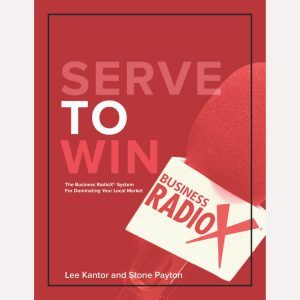
Stone Payton: [00:00:00] All right. Welcome back to Business RadioX Pro Tips. Stone Payton and Lee Kantor here with you. This is our Show Concept Meeting Series. We’ve already spoken opening the show concept meeting. Now, we are prepared to paint the room. We do this with flip charts sometimes. We do it on a piece of paper there on the table sometimes. Walk them through it, Lee. And I’ll chime in if I think I have something to add there.
Lee Kantor: [00:00:24] All right. So, whether we’re doing it on a sheet of paper or flipboard, what we do is we like to draw a rectangle, and then draw circles around the rectangle. Usually, four circles around the ,rectangle two on each side. And we’re putting the guests in the room, and we’re really trying to visualize a studio. We want the prospective client to see a show being built. So, one of those seats around the table are going to be them, the host of the show, which is our prospective client. And then, we’re going to go around the table, and then fill the rest of the seats.
Lee Kantor: [00:00:56] One seat is the person that writes them checks. This is their ideal client. And we start. So, we identify them as one of the seats. And then, not only do we just put ideal client there, we get very granular. We want to know who they are. They are vice presidents of manufacturing firms. We want to know the names of people that they want to put in the room: Bob Smith, Mary Jones. I want to know the companies that those people are with. We want their dream list to start kind of being fleshed out here. We want to know either the companies, the names of the people, the titles. We want to get very specific who that ideal customer is for our sponsor. So, that’s one of the chairs around the table.
Lee Kantor: [00:01:47] Another chair around the table is referral sources. Who are the people that refer business to them that fit into the ecosystem of this show that we’re building for them? And these referral sources could be other professional service firms. They could be complementary businesses that touch this group. So, then, we start listing those out by name and by company.
Lee Kantor: [00:02:13] Another chair around the table is associations, trade associations, business groups. We start listing them out. Most of the niches that we go after, there is some sort of a trade group, or there’s a group that serves that same group of people. And we start listing them. Who is the leadership on that? We get very granular. The more specific, the better. And at this point, you even want to get your perspective customer on the board with the Sharpie, writing their ideas down, and let them kind of co-author this at that point.
Lee Kantor: [00:02:47] The last chair at the table is the kind of micro celebrity or the influencer. And this is the person that might be a blogger. They might have written a book. This person is — this is kind of a warning sign for this kind of person. Since they are kind of the celebrities in that niche that your perspective customer wants to immerse themselves in, they can, all of the sudden, get star struck and say, “Oh, look, I’m interviewing these famous people. And then, I’m famous. And I want to be more famous.” So, you want to just do this a little bit. This is kind of a spice. This is not the entrée. The entrée are the people that write your customers, your prospective customers checks, that’s who you want more of all the time. You want to make sure that somebody in the room always represents that group. The micro celebrity or the influencer, if you do that occasionally, that’s probably enough.
Stone Payton: [00:03:45] I like what you said about co-authoring this. I think that is so key. And yes, when they can get up at the flip chart or on the piece of paper, and they have the pen in their hand, that’s how you know you’re doing it the right way. And I love to ask them, even though I know where I want them to land, and I may have to nudge them a little bit for proper hosting mechanics to get the most out of the platform to truly grow their business, we might ask them, “Well, you know, what do you envision as the format? Like, what kind of questions are you going to ask?” And let them, you know, begin to shape this thing. So, I love the framing of co-authoring. And when you’re doing that, and they are participating at that level, it really sets the stage in a marvelous way for us to begin asking them about return on investment. And that’s the next piece in this series is ROI.














